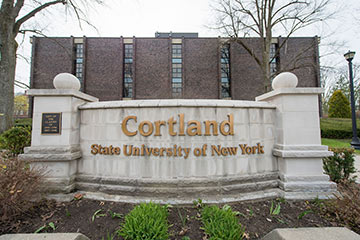
09/16/2020
Now that members of the SUNY Cortland community have successfully completed their first day of COVID surveillance testing (sincere thanks to you all) we wanted to clarify several points of apparent confusion and give you a sense of what this testing could mean for the rest of the semester.
Students, families, faculty and staff should be aware of the following:
- The 100-positive-case threshold set by New York State triggers a temporary shift to remote education, but it does NOT mean the campus will close and students will be sent home. In light of issues this has created on other campuses, SUNY Cortland, with the support of SUNY Chancellor Jim Malatras, has changed its original plan.
- Should SUNY Cortland need to shift away from classroom learning, we will keep the campus open and work to keep students studying in place in Cortland through the end of the semester.
- A period of studying in place is likely to coincide with other restrictions and adaptations of university operations intended to protect students and slow the spread of the virus.
- This change would last for at least two weeks, but will be re-evaluated if testing indicates the outbreak is under control.
- SUNY bases its threshold on the number of positive cases recorded during each of several, two-week periods.
- The current period began Sept. 12 and ends Sept. 26, after which the count returns to 0.
- Consequently, SUNY Cortland has 65 active cases, but only 33 of those positive cases count toward the 100 because the other 32 were discovered before Sept. 12.
- You can monitor the university’s nearness to the threshold through SUNY’s COVID tracking site, under the “metrics by campus” tab.
- Members of our community can track the number of students who are currently positive for the COVID virus as well as the total number of cases (including those who have recovered) on SUNY Cortland’s COVID-19 dashboard.
- This tracker includes both on-campus and off-campus positive cases. The quarantine and isolation metrics, however, include only on-campus numbers.
- We are in the process of re-working the dashboard to provide more clarity.
- Our pooled surveillance testing is done through a process developed by SUNY Upstate Medical University that uses a single saliva sample to do both the general pool test and to re-test individuals within a positive pool.
- The university recently learned that individual, or reflex, testing, is not yet available at Upstate.
- Students who test this week and are in a positive pool will therefore be asked Student Health Services for a traditional nasal swab test. Any employees in a positive pool will be provided additional direction by human resources for the individual test. We are hopeful this additional step will not be needed after this week.
- As we ramp up testing, we expect to discover more cases of COVID infection. Rising numbers could adversely impact our on-campus quarantine and isolation capacity before the 100-case threshold is reached. Although we have access to more than 100 quarantine or isolation beds, many of those rooms are in four-bed suites and currently accommodate only one person, making the university much closer to capacity than it appears. As the need grows, SUNY Cortland may need to:
- Consolidate people who are isolated because of a positive test in the same apartment, even though they may not know each other.
- People who are quarantined on campus because they have had close contact with someone who tested positive may already be lodged together if they share the same connection. Eventually, we may need to start housing people in preventative quarantine together regardless of their connection.
- You are considered a close contact of a person if you have been within six feet of them for longer than 15 minutes within two days of their testing positive or developing symptoms. Simply being in the same classroom, for example, probably does not make you a close contact.
- Students in quarantine on the order of the Cortland County Health Department MUST follow all rules. It is not a suggestion: It is a LAW.
- In addition to county and university disciplinary action, ignoring quarantine requirements could spread the disease, sickening - and possibly killing - people who may be more at risk for illness than asymptomatic or slightly symptomatic students.
- Quarantined or isolated students should not leave their apartment, go to campus or visit a store until their specified time period is up.
- Quarantined or isolated students should not allow visitors or gatherings in their residence.
- All students MUST respond to messages from New York State Health Department contact tracers.
- Students who ignore phone calls, text messages or other attempts to reach them will face disciplinary action by the local health department and the university.
- All information collected by a contact tracer will be strictly confidential and treated as a private medical record. No contact tracer will ever ask you for a social security number or financial information.
- As most SUNY Cortland students understand, the best way to avoid a shift to studying in place is by acting to stem the spread of the virus, thereby preventing the university from reaching the 100-case mark. Although compliance on campus has been very good, there appears to be significantly less compliance among off-campus students.
- All students must continue to avoid groups, physically distance, wear face coverings and wash or sanitize hands frequently, especially when they are off campus and into the community.
- Disregarding these and other guidelines not only endangers the health of other students, faculty and members of the Cortland community. It threatens student careers. SUNY Cortland has already suspended students for serious or repeated violations and will continue to do so. This is a potentially life-or-death issue. Violators will find little sympathy at SUNY Cortland.